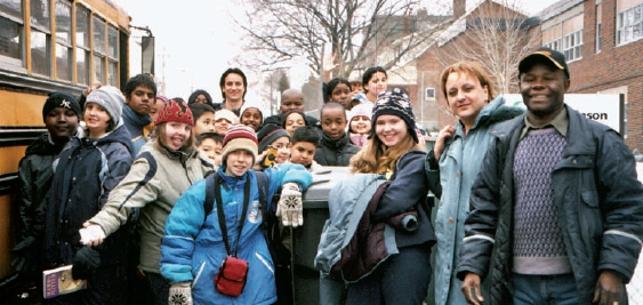
Going Outside to Create Tomorrow's Engaged Citizen
Every year I take my grade 6 class to my childhood playground – not the metal monkey bars, swings, or asphalt tarmac that most children think of as a “playground” but the open fields, streams, and forests near Shelburne, Ontario where I spent countless hours exploring, climbing trees, collecting tadpoles, and building forts.
It was in this carefree world, devoid of adult intervention, that I discovered a sense of freedom and belonging and where my appreciation and love for the outdoors began. The trees, the the water, and the air were my textbooks. From them I learned that in nature everything is Interconnected.
With many outdoor centres on the loosing end of the battle of resources, perhaps it’s time to think about how we can teach our children one of the most important literacy skills – environmental literacy! It is an almost impossible task to develop the connection with the environment if students are confined within a traditional classroom.
For me, environmental literacy is much more than an academic understanding of the environment and its role in sustaining life on earth. It is about engaging students so they question established truths. It’s about helping them make informed decisions about the environment as well as about their own health.
Today, 82 percent of Canadian children under 12 live in an urban area.1 Most have little or no experience of life in a rural setting. Canadians have some of the highest Internet usage rates in the world, according to world-renowned Canadian scientist David Suzuki.2 He reported on research that shows “per capita visits to national parks (mainly in the USA) have been declining for nearly 20 years – largely as a result of increased time spent watching television and movies, playing video games and surfing the web.”3 The researchers concluded, “We may be seeing evidence of a fundamental shift away from people’s appreciation of nature biophilia,4 to videophilia … the new human tendency to focus on sedentary activities involving electronic media.”
A unique experience
The relationships and interactions between living things and their natural environment were things that I had the privilege of studying without even knowing I had signed up for the course. For me, it was just part of growing up in a rural setting. But for most of my students, it is a three-day “crash” course that happens only once in their time in elementary school.
The Sheldon Valley Outdoor Education Centre is one of five residential outdoor education centres the Toronto District School Board operates. These centres provide a unique opportunity for inner-city children. Nestled amidst rolling hills 15 km west of Alliston, Sheldon comprises 79 hectares of diverse field, stream, and forest habitats.
For many of my students, a trip to Sheldon is not only their first time away from home but also their first time outside the city. Some are so excited that they begin right away taking pictures to capture every minute of the trip, using up all their film by the time we get to Sheldon. Many are shocked to find they’ll be spending three days without access to telephones, television, video games or the Internet!
Upon arrival at Sheldon the immediate surroundings and the displays of wildlife and artifacts quickly awaken students’ interest and awareness of the environment. Students learn about responsibility, sharing, management, and civics. Individual responsibilities include making beds and cleaning the main building. Group responsibilities include setting and clearing the table. After a meal students carefully measure the compost, recycling, and garbage: their challenge is to create less garbage than groups that have come before.
Hands-on learning
The farm and its animals are an integral part of the learning at Sheldon. Students learn to clean stalls and tend to livestock. They are often aghast that farm life involves shovelling animal waste but they get over the smells before long and really enjoy the physical work. Direct engagement with the environment and hands-on activities help students develop informed opinions, which in turn shape their attitudes and values.
An example of this is an activity called “Web of Life.” Students take on the role of an herbivore, omnivore, or carnivore. They must locate food and water sources, while at the same time avoid- ing natural enemies, disease, and disaster. (See the curriculum insert for a description of the game.) This activity provides students with an increased understanding of the food chain and of the interdependency of all living creatures.
Outdoor learning is not just for students; teachers also benefit. Tom Puk, a professor at Lakehead University, conducted a study that showed 71 percent of Ontario elementary school teachers believed their students were ecologically illiterate. About one third of teachers said they themselves did not know enough about ecology and almost all wanted more professional development in the area.5
Because onsite experts lead most of the programs at the Sheldon Centre, classroom teachers get the time to step back and observe. I’ve observed my students at length while learning what they learn. I’ve also participated in such activities as crossing a cable bridge with them. It’s been my experience that students are thrilled to see their teacher outside the regular classroom, learning and doing the same things they are.
I’ve also seen students who struggle academically excel in activities like “Web of Life” because it focuses on different kinds of intelligences than classroom learning does. This kind of active learning has a long-lasting impact. It always amazes me when visiting graduates remember in-depth moments from the three-days they spent at Sheldon.
It is exciting to know that many of my students will experience, for the first time, what I experienced as a young boy – the wonders and beauty of a rural setting. When I look up into a night sky with my students and see the stars or hear the call of an owl it’s as if I’ve stepped back into my childhood. I feel as if I’ve taken them back to my childhood home.
In a recent interview Ontario Environmental Commissioner Gordon Miller asked: “How can we transform our economy and society so that we can respond to the environmental challenges that are facing us if we raise a generation of ecologically illiterate children?”6 It’s something we all need to think about. Teachers can make a difference by understanding the values of environmental literacy. An “outdoor” education can help create a better-informed and more engaged citizen.
Notes
1. Colombo, John Robert, ed. Canadian Global Almanac, Toronto: Macmillan Canada, 1998.
2. Suzuki, David. “Reality TV the closest some children get to reality.” Science Matters, July 28, 2006. Available at davidsuzuki.org
3. The original research can be found in Pergams, Oliver R.W., and Patricia A. Zaradic. “Is love of nature in the US becoming love of electronic media?” Journal of Environmental Management 80.4 (2006), 387-93
4. Quoted in Suzuki, “Reality TV.”
5. Toronto Star, October 10, 2006.
6. Toronto Star, October 10, 2006.
Environment Curriculum Resources – yours for the asking
The Toronto District School Board’s EcoSchools program has extensive curriculum materials available on its website: ecoschools.tdsb.on.ca
- GRASP: A tool for developing ecological literacy through rich performance tasks
- Conservation of Energy: Inquiry Activities for Kids ( Teacher’s Resource)
- The Toronto Wind Turbine: Virtual Tour for Kids ( Teacher’s Resource)
The SEEDS Foundation sponsors the Green Schools program and offers an Interactive Energy Literacy series. Available at seedsfoundation.ca.
Greenlearning.ca is a project of the Pembina Institute developed to bring accurate and engaging educational materials to students, teachers, and parents.
Re-energy.ca is a renewable energy and sustainable transportation education website that provides teachers with downloadable teaching materials. Students can build small-scale models of wind turbines, solar cars, and more.
The Sierra Club of Canada offers free environ- mental education material. Its 70-minute work- shops use games to teach the students about issues from climate change to waste reduction. Available without charge at ontario.sierraclub. ca/ottawa/education.php.
The Canadian Wildlife Federation offers Project Wild at wildeducation.org
The Council of Outdoor Educators of Ontario publishes Pathways Journal at coeo.org
Environmental Education Ontario offers Greening the Way Ontario Learns: A Public Strategic Plan for the Advancement of Environmental Literacy at eeon.org.
The Ontario Society for Environmental Education at osee.org

